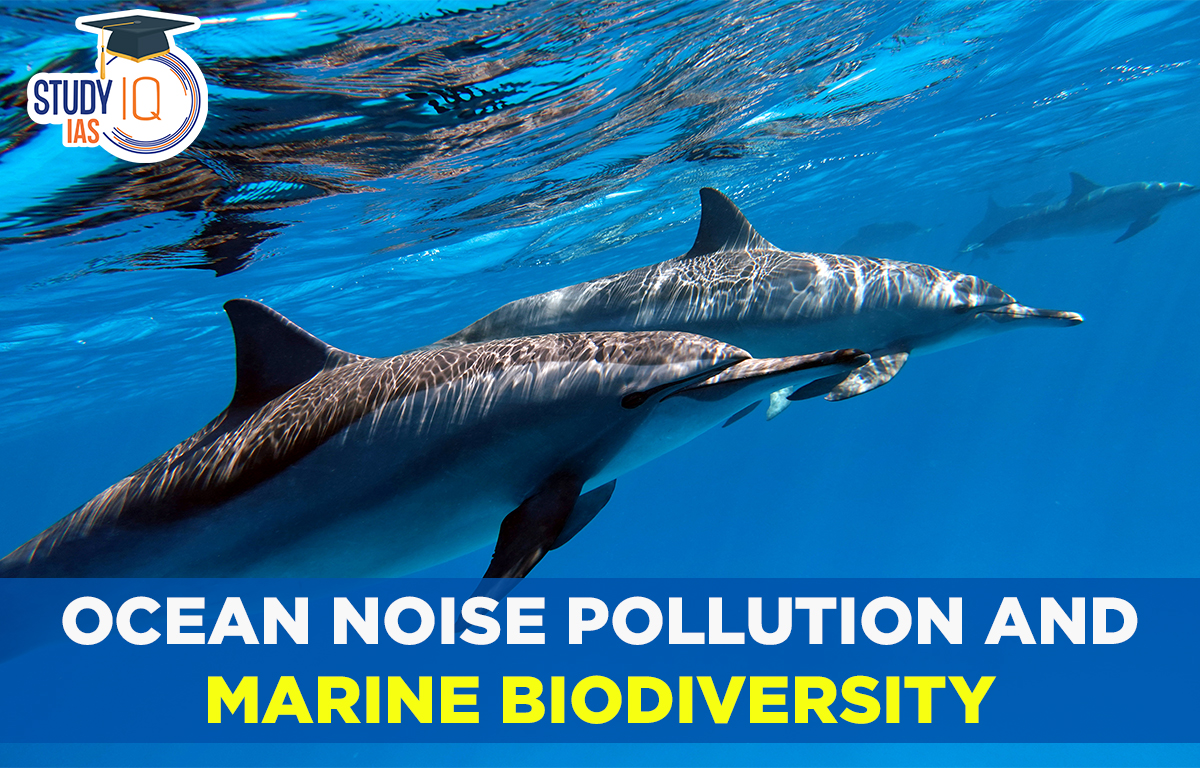Table of Contents
Key Highlights Of Ocean Noise Pollution and Marine Biodiversity
- This study was published under the title ‘Anthropogenic noise impairs cooperation in bottlenose dolphins.’
- Significance of sound for dolphins: Dolphins rely heavily on sound production and reception to navigate, communicate, hunt, and avoid predators in dark or limited vision waters.
- How does ocean noise pollution affect dolphins?
- Anthropogenic noise coming from large commercial ships, military sonars or offshore drilling can severely impact their well-being.
- Through an experiment, the study has found that noise pollution impacts their behaviour to communicate and work together, which in turn affects their ability to navigate, and forage.
Bottlenose Dolphin
- These are aquatic mammals belonging to the family of oceanic dolphins.
- They contain two species: the common bottlenose dolphin and the Indo-Pacific bottlenose dolphin.
- They inhabit warm and temperate seas worldwide, except for the Arctic and Antarctic Circle regions.
- Conservation status of the Indo-Pacific bottlenose dolphin:
- IUCN Red List: Near Threatened
- CITES: Appendix II
About Ocean Noise Pollution
- Ocean noise refers to sounds made by human activities that can interfere with or obscure the ability of marine animals to hear natural sounds in the ocean.
- The critical role played by sound in the lives of marine animals:

- Sources of Ocean Noise Pollution:
- The main sources are human activities such as shipping, oil and gas exploration and production, construction, and naval sonar.
- Other sources include commercial and recreational fishing, and underwater blasting.
- Climate change also contributes to ocean noise pollution through the melting of sea ice and the increased frequency of storms.
Stats IQ: Current Scenario of Ocean Noise Pollution
- According to a 2019 report from the United Nations, shipping is responsible for the majority of ocean noise pollution, with the number of ships increasing by 2.5% per year.
- The report states that shipping traffic in some areas is now up to 10 times higher than in the 1960s, and this increase in noise is having a detrimental impact on marine life.
- Another report, published in the journal “Nature” in 2018, found that ocean noise has increased by roughly 3 decibels per decade since the 1960s, with some areas experiencing increases of up to 10 decibels per decade.
- How Ocean Noise Pollution Impacts Marine Biodiversity?
- Disruption of communication: Noise pollution can disrupt their communicating behaviours, leading to a decrease in population numbers and diversity.
- Stress response: Exposure to noise pollution can cause a stress response in marine animals, leading to changes in behaviour and physiology, and an increased risk of disease and death.
- Masking of important sounds: Noise pollution can mask important sounds that marine animals rely on, such as the sounds of prey or potential mates, leading to difficulty in finding food and reproducing.
- Changes in distribution and abundance: Noise pollution can cause changes in the distribution and abundance of marine species, leading to a decrease in biodiversity in certain areas and an increase in others.
- Reduced productivity: Noise pollution can negatively impact the productivity of marine ecosystems, leading to a decrease in overall biodiversity.
Case Study: Mass Stranding Of Whales On Tasmania’s West Coast
- In 2020, Australia witnessed one of its worst mass stranding of whales when around 200 of them died on Tasmania’s west coast.
- Researchers suggest that mass stranding is linked to noise pollution in oceans, which have a negative impact on the survival and well-being of marine mammals.



 Phone-tapping in India, Legal Framework ...
Phone-tapping in India, Legal Framework ...
 Bihar Assembly Election 2025 Dates, Poli...
Bihar Assembly Election 2025 Dates, Poli...
 Jharkhand High Court Assistants Admit Ca...
Jharkhand High Court Assistants Admit Ca...





















